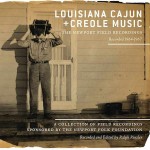The Newport Folk Foundation played a pivotal role in the resurgence of Cajun-Creole music when its future looked bleak. At the 1964 Newport Folk Festival, a performance by a Cajun trio that included Dewey Balfa turned out to be a turning point when an audience of 17,000 gave them a thunderous, standing ovation. Since local popular opinion had scoffed at the idea of Cajun musicians playing out-of-state beforehand, the response came as a welcome surprise. Balfa would go on to become a cultural spokesperson, urging his fellow Cajuns to be proud of their music. Cajun-Creole bands were booked in successive years; Adam and Cyprien Landreneau in ’65, “Bois Sec” Ardoin and Canray Fontenot in ’66 and Les Frères Balfa in ’67.
Between 1964 and 1967, the Foundation’s folklorist emeritus Ralph Rinzler visited Louisiana and made these field recordings of the aforementioned plus Austin Pitre and the Evangeline Playboys, ballad singer/fiddler Edius Naquin, and a trio consisting of Isom Fontenot, Preston Manuel and Aubrey DeVille. Now, in its third generation of reissue, both volumes of Rounder’s historical Louisiana Cajun French Music are combined into one epic, 27-track disc. Though that fact is omitted from the physical packaging, it is mentioned in the vastly expanded liner notes, an 84-page PDF document embedded in the disc. Incidentally, be prepared to spend some time digesting the document’s articles, interviews and lyric translations.
Many of the tunes heard here are sonic signatures of their respective performers, such as the Balfa Brothers’ “Parlez-nous à boire,” Canray Fontenot’s “Bonsoir, Moreau” and Austin Pitre’s “Les flames d’Enfer.” Armed with quality equipment, Rinzler certainly captured the best of his subjects. The performances are often gut- wrenchingly powerful and highly emotive, causing them to resonate within the soul some six decades later.





